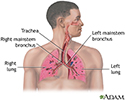Pulmonary nocardiosis
Nocardiosis - pulmonary; Mycetoma; Nocardia
Pulmonary nocardiosis is an infection of the lung with Nocardia bacteria.
Causes
Nocardia infection develops when you breathe in (inhale) the bacteria. The infection causes pneumonia-like symptoms. The infection can spread to any part of the body.
People with a weak immune system are at a high risk for nocardia infection. This includes people who have:
- Been taking steroids or other medicines that weaken the immune system for a long time
- Cushing disease
- An organ transplant
- HIV/AIDS
- Lymphoma (a type of cancer)
Other people at risk include those with long-term (chronic) lung problems related to smoking, emphysema, or tuberculosis.
Symptoms
Pulmonary nocardiosis mainly affects the lungs. But, nocardiosis can also spread to other organs in the body. Common symptoms may include:
ENTIRE BODY
GASTROINTESTINAL SYSTEM
- Nausea
- Liver and spleen swelling (hepatosplenomegaly)
- Loss of appetite
- Unintentional weight loss
- Vomiting
LUNGS AND AIRWAYS
- Breathing difficulty
- Chest pain not due to heart problems
- Coughing up blood or mucus
- Rapid breathing
- Shortness of breath
MUSCLES AND JOINTS
NERVOUS SYSTEM
SKIN
- Skin rashes or lumps
- Skin sores (abscesses)
- Swollen lymph nodes
Exams and Tests
Your health care provider will examine you and listen to your lungs using a stethoscope. You may have abnormal lung sounds, called crackles. Tests that may be done include:
- Bronchoalveolar lavage -- fluid is sent for stain and culture, which is taken by bronchoscopy
- Chest x-ray
- Chest CT
- MRI scan of the chest
- Pleural fluid culture and stain
- Sputum stain and culture
Treatment
The goal of treatment is to cure the infection. Antibiotics are used, but it may take a while to get better. Your provider will tell you how long you need to take the medicines. This may be for up to a year.
Surgery may be needed to remove or drain infected areas.
Your provider may tell you to stop taking any medicines that weaken your immune system. Never stop taking any medicine before talking to your provider first.
Outlook (Prognosis)
The outcome is often good when the condition is diagnosed and treated quickly.
The outcome is poor when:
- The infection spreads outside the lung.
- Treatment is delayed.
- The person has a serious disease that leads to or requires long-term suppression of the immune system.
Possible Complications
Complications of pulmonary nocardiosis may include:
- Brain abscesses
- Skin infections
- Kidney infections
When to Contact a Medical Professional
Contact your provider if you have symptoms of this disorder. Early diagnosis and treatment may improve the chance of a good outcome.
Prevention
Be careful when using corticosteroids. Use these medicines sparingly, in the lowest effective doses and for the shortest period of time possible.
Some people with a weak immune system may need to take antibiotics for long period of time or indefinitely to prevent the infection from returning.
References
Dockrell DH, Ho A, Gordon SB. Community-acquired pneumonia. In: Broaddus VC, Ernst JD, King Jr TE, et al, eds. Murray and Nadel's Textbook of Respiratory Medicine. 7th ed. Philadelphia, PA: Elsevier; 2022:chap 46.
Southwick FS. Nocardiosis. In: Goldman L, Cooney KA, eds. Goldman-Cecil Medicine. 27th ed. Philadelphia, PA: Elsevier; 2024:chap 306.
Review Date: 8/19/2024

























